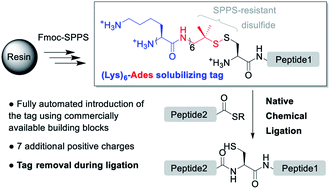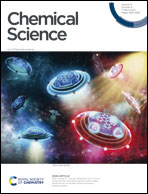A straightforward methodology to overcome solubility challenges for N-terminal cysteinyl peptide segments used in native chemical ligation†
Abstract
One of the main limitations encountered during the chemical synthesis of proteins through native chemical ligation (NCL) is the limited solubility of some of the peptide segments. The most commonly used solution to overcome this problem is to derivatize the segment with a temporary solubilizing tag. Conveniently, the tag can be introduced on the thioester segment in such a way that it is removed concomitantly with the NCL reaction. We herein describe a generalization of this approach to N-terminal cysteinyl segment counterparts, using a straightforward synthetic approach that can be easily automated from commercially available building blocks, and applied it to a well-known problematic target, SUMO-2.

- This article is part of the themed collection: Most popular 2021 chemical biology articles


 Please wait while we load your content...
Please wait while we load your content...